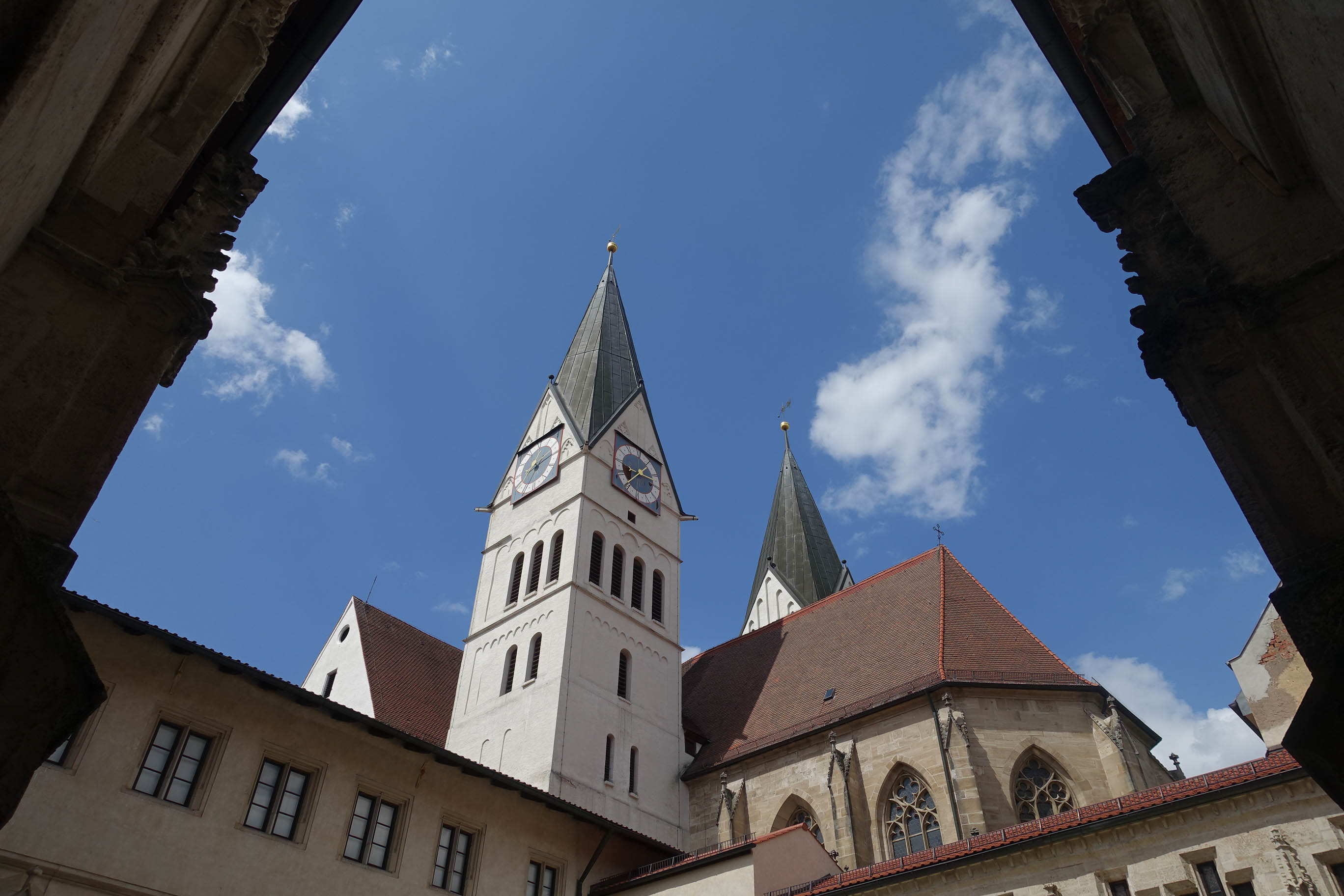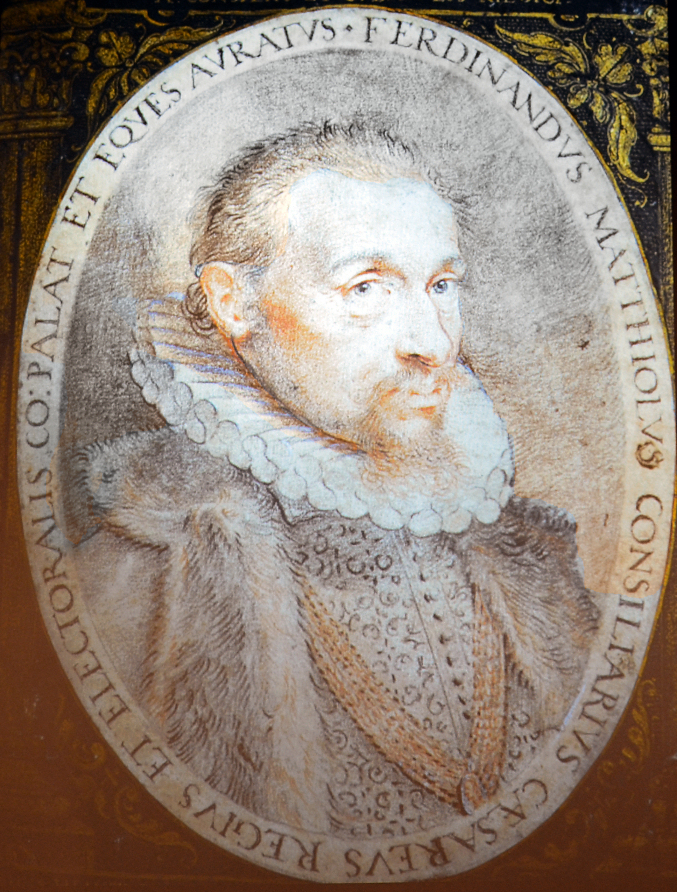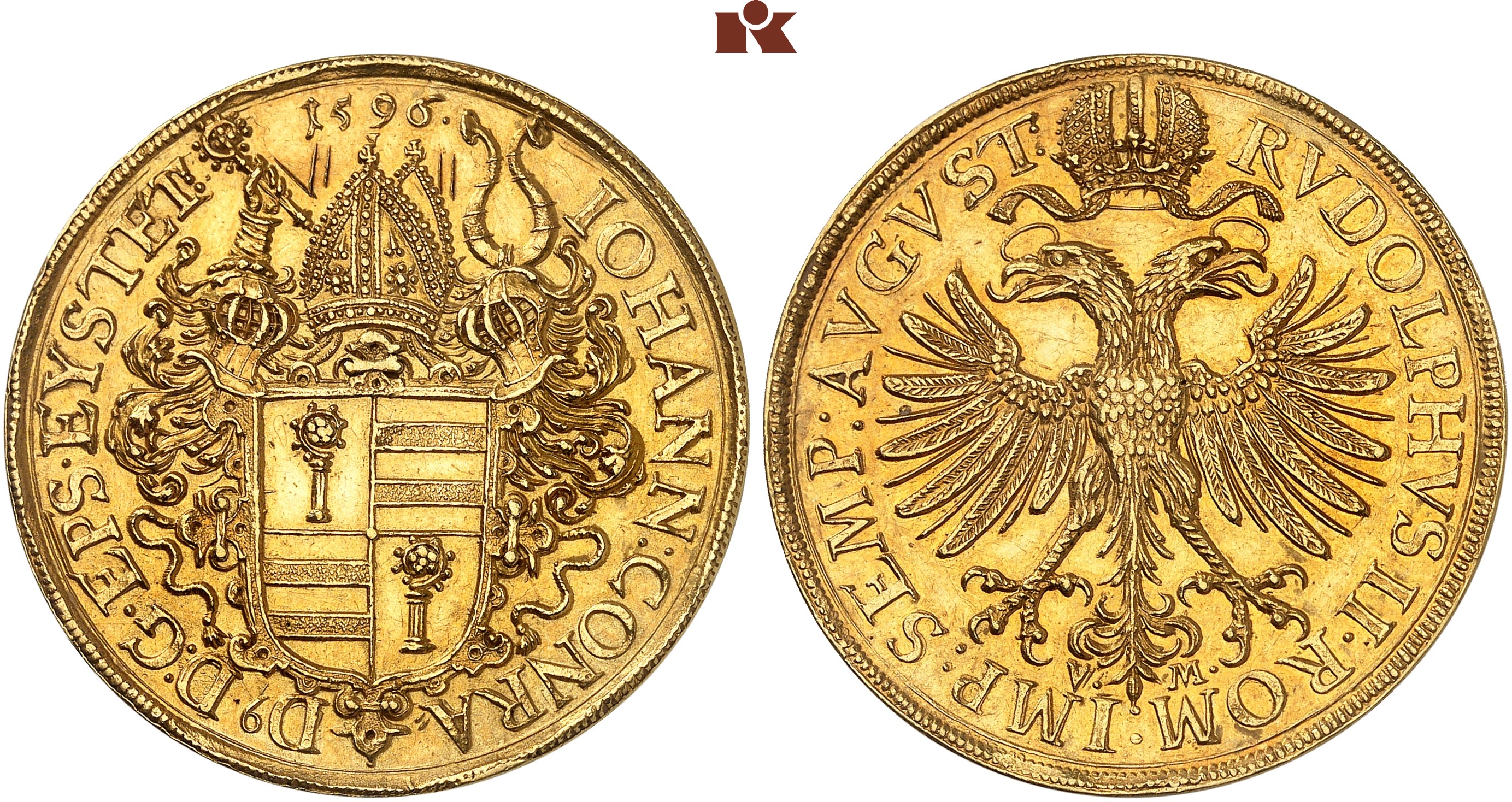Why Did Johann von Gemmingen Mint His 1596 Coins?
12. January 2023
On 2 February 2023, we will hold our long-established Berlin Auction Sale. 730 lots with a total estimate of 6 million euros will be on sale that day, including a great rarity from Eichstätt: a donativum of 8 ducats from 1596 minted on behalf of Johann Konrad von Gemmingen.
On the obverse, this coin shows the episcopal coat of arms of Eichstätt. It consists of the coat of arms of the Prince-Bishopric, the crook of the crosier, and the coat of arms of the Gemminger family – two yellow ribbons against a blue background. The translation of the inscription reads: Johann Konrad Bishop of Eichstätt by God’s grace. The reverse shows the crowned imperial eagle with the circumscription Rudolf II, Roman Emperor, Always Ruler.
This article deals with the question of why Johann Konrad of Eichstätt had this coin minted and what purpose it served.

Eichstätt Cathedral, view from the cloister. Photo: KW.
The Prince-Bishopric of Eichstätt
Although the Bishopric of Eichstätt wasn’t one of the largest ecclesiastical dominions in the Holy Roman Empire, it was one of the bishoprics in which the bishop not only held powers in matters of faith but also had temporal power. That was attractive. Therefore, it was not only local imperial knight families who competed for the office as Bishop of Eichstätt – princely houses such as the Wittelsbach dynasty, which hoped to find a suitable place for their second, third or fourth born sons, also joined the competition. Only a few chapters could resist them. One of them was the chapter of the Eichstätt Cathedral.
Cathedral Chapter, Bishop and Coadjutor
This cathedral chapter faced a problem in the 1590s: Bishop Kaspar von Seckendorff was not able to get a grip on Eichstätt’s ever-growing debt. So it was quite convenient that he was living in a relationship with a woman – his cook – that was similar to marriage. Although most clergymen had such relationships at the time, this provided an excellent pretext to remove Kaspar from office. And because the Bavarian duke, who had good connections to the pope, wanted to make one of his sons bishop of Eichstätt, he made sure that the papal nuncio interfered in the matter. We don’t know who came up with the idea of electing a coadjuntor while Seckendorff was still alive. It surely was a solution – but one that threatened Eichstätt’s independence.
After all, a coadjuntor referred to someone who assisted the bishop and automatically succeeded him after his death. This means, no election would take place after the bishop’s death. But if a bishop held these elections while he was still alive, he could determine when they took place, thereby influencing the outcome. The Wittelsbach dynasty had used this office to introduce a secundogeniture in numerous bishoprics. And this was the very reason why the chapter of the Eichstätt Cathedral had never elected a coadjuntor before – and was only to do so twice throughout its history.
So the chapter had to decide whether they wanted to go the dangerous path of electing a coadjuntor or to make do with loathed Kaspar von Seckendorff. However, the Bavarians, who were keen to get their hands on the episcopal office, made the mistake of not taking the solidarity of the imperial knights into account, which opened up a third solution.

Memorial plaque of Johann Konrad von Gemmingen at Eichstätt Cathedral. Photo: KW.
The Election and Taking Office of Johann Konrad von Gemmingen
The preferred candidate of the chapter was Johann Konrad von Gemmingen. Kaspar von Seckendorff agreed to the election after he had concluded a contract with the chapter that was rather beneficial to him. Part of the agreement was the provision that Johann Konrad von Gemmingen would immediately start his reign in the Bishopric of Eichstätt. However, the chapter and the bishop delayed their agreement until the papal nuncio departed again. In this way they prevented a precedent from being set that would make the election of the coadjuntor a matter regulated by the Pope.
This very election of the coadjuntor is the reason why there are several dates referring to the assumption of office by Johann Konrad. Every single event could have been the reason for celebrations that might be associated with the issuance of coins.
On 18 November 1593, the chapter elected him as coadjuntor. The papal confirmation followed on 28 February 1594. The solemn assumption of office started on 24 May of the same year, and the emperor confirmed his temporal power on 23 August 1594. Johann Konrad celebrated his actual ordination as bishop on 2 July 1595 after deposed Kaspar von Seckendorff had died on 2 April of the same year.
And this presents us with a problem: we cannot connect any of these many dates with the 1596 donativum offered at Künker.

Philipp Hainhofer, around 1610.
The Testimony of Philipp Hainhofer
Luckily, we have another source to help us. Philipp Hainhofer, a dazzling diplomat and art agent travelled to Eichstätt from 16 to 27 May 1611. He left us a detailed description of his visit. Of particular interest for our purposes is his report of 20 May, when Prince-Bishop Johann Konrad von Gemmingen received him.
The time of the audience is somewhat unusual for us: 6 in the morning. Before the introduction of artificial light, even princes took advantage of the long days before the summer solstice. The Prince-Bishop had dressed up for the occasion. He wore a precious robe of brown damask, lined with marten fur. This is how he sat at his desk in his cabinet of curiosities (Kunstkammer), where the famous Eichstätt collections were kept. Johann Konrad von Gemmingen was a passionate collector, whose cultural ambitions were highly appreciated by his contemporaries. Even today we know the garden that he had landscaped on the bastions of Willibaldsburg Castle, and whose plants were published in the lavishly illustrated book Hortus Eystettensis from 1613.
It was quite logical that the Prince-Bishop met the diplomat in his Kunstkammer. After all, the official reason for Hainhofer’s presence was that he was traveling on behalf of the resigned Bavarian Duke William V and was planning to purchase interesting collectibles for Philip II of Pomerania-Stettin. In fact, Hainhofer was probably trying to convince Eichstätt to join the Catholic League, which had been founded in 1609, on behalf of the Bavarian Duke Maximilian I. His efforts were in vain. The chapter of the Eichstätt Cathedral had fought too hard for its independence to risk being influenced by Bavaria in this way. It was not until before the outbreak of the 30 Years’ War that Konrad’s successor felt compelled to do so.
Therefore, Johann Konrad von Gemmingen kept a low profile and showed his art-interested guest one precious object after the other. Of course, he gave the usual diplomatic gift to Philipp Hainhofer. The latter described this event in the following words (translated into modern English): “In a large drawer [of the desk] was a pile of gold coins, namely of ten and six ducats, which His Princely Grace had minted at the beginning of his reign. He honored me with several of them to put to the other coins I had received from princes.”
Thus, Johann Konrad had a number of diplomatic gifts produced at the beginning of his rule in 1596, which he did not distribute at once at a great feast but one after the other, whenever a diplomatic gift was needed.
By the way, these coins are listed in the inventory of Hainhofer’s collection as “several gold coins, of 10 and 6 ducats, from the beginning of the reign of Bishop Johann Konrad of Eichstätt, a gift of his from 20 May 1611.”
We know from other sources that Johann Konrad gave a gold coin to the Bavarian councilor Dr. Franziscus Soll because he supported the interests of Eichstätt. The son of Count Palatine Philipp Ludwig of Palatinate-Neuburg also received a multiple gold coin when he visited the bishop. We can only speculate about whether the numerous specimens of this series that are kept at the KHM Vienna today – the successor institution of the imperial collection – were also gifts for the Habsburgs. After all, the Habsburgs were the natural allies of the Eichstätt Bishop against the Bavarian Duke.
And therefore, Eichstätt coins of 1596 provide us with a lot of insight into the practice of diplomatic gift exchange, as it was also upheld by Johann Konrad von Gemmingen.


